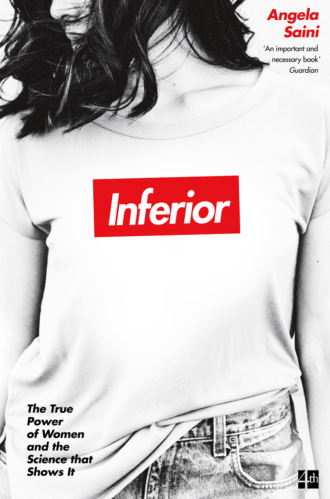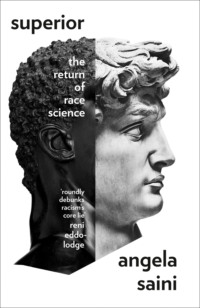
Полная версия
Inferior: How Science Got Women Wrong – and the New Research That’s Rewriting The Story
In this book, I unpick some of these studies and interview the people behind them. Doing so has revealed a body of work that should make every one of us ask questions. Some scientists claim that women are on average worse than men at mathematics, spatial reasoning and anything that requires understanding how systems – such as cars and computers – work, and that this is because women’s brains are structurally different from men’s brains. There are those who insist that men played the dominant part in human evolutionary history because they hunted animals, while women had the apparently less challenging role of staying behind and caring for children. One person argues that humans have evolved to be as smart and creative as we are because of the actions of men. Another, that women experience the menopause because men don’t find older women attractive.
It can be hard to query the motives behind theories like these. Words that would sound deeply objectionable at a dinner party can seem remarkably plausible when they’re falling from the mouth of someone in a lab coat. But we need to be sceptical. The study you read about in the newspaper telling you that men are better at reading maps or parking than women, for example, may be entirely contradicted by another study on a different population, in which women happen to be better map-readers or parkers. The beautiful brain scan is not the photograph of our thoughts that it claims to be. And in some branches of science, such as evolutionary psychology, theories may be little more than thin scraps of unreliable evidence strung into a narrative.
If studies seem sexist, occasionally it’s because they are. It’s impossible to expect the deep prejudice that kept women out of science for centuries not to have affected the very blood and bones of science. In the past, and to this day.
But this isn’t the whole story.
Having more women in science is changing how science is done. Questions are now being asked that were never asked before. Assumptions are being challenged. Old ideas are giving way to new ones. The distorted, often negative picture that was painted of women in the past has been powerfully tested in recent decades by researchers – many of whom are women, but men too – who have found it flawed. And this alternative portrait reveals humans in a completely different light.
Today, away from the barrage of questionable research on sex differences, we have a radically new way of thinking about women’s minds and bodies. Fresh theories on sex difference, for example, suggest that the small gaps that have been found between the brains of women and men are merely statistical products of the fact that we are all unique. Decades of rigorous testing of girls and boys confirm that there are few psychological differences between the sexes, and that what differences can be seen are heavily shaped by culture, not biology. Research into our evolutionary past shows that male domination and patriarchy are not biologically hardwired into human society, as some have claimed, but that we were once an egalitarian species. Even the age-old myth about women being less promiscuous than men is being shown the door. Here too, society plays a greater role in our behaviour than does our biology.
This is well-evidenced, careful work that challenges traditional ideas about what it means to be a woman. The picture isn’t of someone who’s weak or subservient. She’s not less able to excel in science, nor is she any of the softly patronising adjectives that have been used to mark her apart from men as a member of the fairer, gentler sex. This woman is as strong, strategic and smart as anyone else.
It’s a compelling body of scientific research which, rather than pulling women and men further apart in the gender wars, affirms the importance of sexual equality. It draws us closer together.
When I was promoting my first book, Geek Nation, I went to the city of Sheffield to give a talk. At the end, a short, middle-aged man came over to ask some questions in private.
‘Where are all the women scientists? Where are the women Nobel Prize-winners?’ he asked, sneering. ‘Women just aren’t as good at science as men are. They’ve been shown to be less intelligent.’ He pressed up so close to my face that I was backed into a corner. What was a sexist rant rapidly became racist, too. I tried to argue back. I listed the accomplished female scientists I knew. I hastily marshalled a few statistics about school-age girls being better at mathematics than boys. But in the end I gave up. There was nothing I could say that would make him think of me as his equal.
How many of us haven’t known someone like him? The patronising boss. The chauvinistic boyfriend. The online troll. What I wish I had is a set of scientific arguments in my armoury to show them that they are wrong. To reinforce the fact that equality isn’t just a political ideal, but every woman’s natural, biological right.
For everyone who has faced the same situation I did in Sheffield, the same angry confrontation with a person who tells you that women are inferior to men, and the same desperate attempt not to lose control but to have at hand some hard facts and a history to explain them, this book is for you. In it I travel through the life stages of a woman, from birth through working life, motherhood and menopause, into older age, to interrogate what science really tells us, and the controversies around what remains uncertain.
Despite my personal experiences, I didn’t set out to write this book with an axe to grind. As a journalist, I have a commitment to the real facts. And as someone with an academic background in science and engineering, I wanted to better understand the research. The work I examine spans neuroscience, psychology, medicine, anthropology and evolutionary biology. Starting in the nineteenth century and running all the way to today, I’ve tried to find out why so much of what we think of as true is actually unreliable. I investigate the studies that have hit the headlines, claiming to show that stereotypes about women are backed by science. And at the same time I explore the empowering new portrait of women, which looks so different from the old one.
This doesn’t always make for comfortable reading. The facts are sometimes greyer than people might want them to be. The research doesn’t always tell us what we want it to. But this is an account of the evidence and the debates as they stand now, chronicling the bitter scientific struggle for the heart and soul of women.
For me, this struggle represents the final frontier for feminism. It has the potential to knock down the greatest barrier that still stands between women and full equality – the one in our minds. As anthropologist Kristen Hawkes at the University of Utah put it to me when I interviewed her about her work on the menopause for the final chapter of this book: ‘If you’re really paying attention to biology, how can you not be a feminist? If you’re a serious feminist and want to understand what the underpinnings of these things are, and where they come from, then biology – more science, not less science.’
Конец ознакомительного фрагмента.
Текст предоставлен ООО «ЛитРес».
Прочитайте эту книгу целиком, купив полную легальную версию на ЛитРес.
Безопасно оплатить книгу можно банковской картой Visa, MasterCard, Maestro, со счета мобильного телефона, с платежного терминала, в салоне МТС или Связной, через PayPal, WebMoney, Яндекс.Деньги, QIWI Кошелек, бонусными картами или другим удобным Вам способом.





